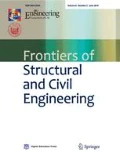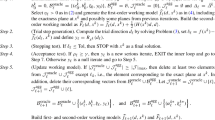Abstract
A normalized space constructed by tensor product is used in field function approach to give a special case of moving least squares (MLS) interpolation scheme. In the regular domain, the field function which meets homogenous boundary conditions is constructed by spanning base space to make the MLS interpolation scheme simpler and more efficient. Owing to expanded basis functions selection, some drawbacks in general MLS method, for example repeated inversion, low calculation efficiency, and complex criterions, can be avoided completely. Numerical examples illustrate that the proposed method is characterized by simple mathematical concept, convenient repeat calculations with high accuracy, good continuity, less computation and rapid convergence.
Similar content being viewed by others
References
Belytschko T, Krongauz Y, Organ D, et al. Meshless methods: an overview and recent developments. Compute Methods Appl Mech Engrg, 1996, 139: 3–47
Donning B M, Liu W K. Meshless methods for shear-deformable beams and plates. Computer Methods in Applied Mechanics and Engineering, 1998, 152: 47–71
Nayroles B, Touzot G, Villon P. Generalizing the finite element method: diffuse approximation and diffuse elements. Computational Mechanics, 1992, 10: 307–318
Atluri S N, Zhu T. A new meshless local Petrov-Galerkin (MLPG) approach in computational mechanics. Computational Mechanics, 1998, 22: 117–127
Braun J, Malcolm S. A numerical method for solving partial differential equations on highly irregular envolving grids. Nature, 1995, 376(24): 655–660
De S, Bathe K J. The method of finite sphere. Computational Mechanics, 2000, 25: 329–345
Shen Pengcheng, He Peixiang. Multi-variables spline finite element method. Acta Solida Mechanic, 1994, 15(3): 234–243 (in Chinese)
Qin Rong. Spline Boundary Element Method. Nanning: Guangxi Science & Technique Press, 1988 (in Chinese)
Liu Xiaoyao. Spline Functions and Structure Mechanics. Beijing: People Communication Press, 1990 (in Chinese)
Hollig K. Finite Element Methods with B-spline. Stuttgart, Germany: SIAM, Philadelphia, 2003
Author information
Authors and Affiliations
Corresponding author
Additional information
__________
Translated from Journal of Huazhong University of Science and Technology (Nature Science), 2007, 35(2): 8–11 [译自: 华中科技大学学 报(自然科学版)]
Rights and permissions
About this article
Cite this article
Sun, H., Wang, Y. & Miao, Y. Meshless numerical method based on tensor product. Front. Archit. Civ. Eng. China 2, 166–171 (2008). https://doi.org/10.1007/s11709-008-0021-y
Published:
Issue Date:
DOI: https://doi.org/10.1007/s11709-008-0021-y




